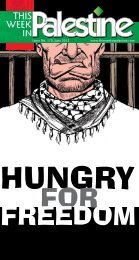Municipalities and Councils - Australians for Palestine
Municipalities and Councils - Australians for Palestine
Municipalities and Councils - Australians for Palestine
You also want an ePaper? Increase the reach of your titles
YUMPU automatically turns print PDFs into web optimized ePapers that Google loves.
Exhibitions of the Month<br />
Beyond Aesthetics<br />
The Unspoken Language of Palestinian Dress<br />
22 June to 20 August 2011 at the Birzeit<br />
University Ethnographic <strong>and</strong> Art Museum<br />
It has been customary <strong>for</strong> Palestinian<br />
costumes to be shown, exhibited, <strong>and</strong><br />
studied in a geographical context,<br />
whereby each garment is associated with<br />
a specific region of <strong>Palestine</strong> from which<br />
its construction, style, <strong>and</strong> meanings<br />
are discussed. This exhibition, however,<br />
tries to explore the extent <strong>and</strong> breadth of<br />
the symbolism found in village-peasant<br />
(falahi) <strong>and</strong> Bedouin dress as a tool of<br />
communication, protection, <strong>and</strong> social<br />
interaction. It highlights the use of<br />
colours, imagery, shapes, materials, <strong>and</strong><br />
mannerisms as means <strong>and</strong> methods<br />
of transmitting messages pertinent to<br />
aspects of life in <strong>Palestine</strong> up to the mid-<br />
20th century. The exhibition elaborates<br />
on the relationship of the costumes <strong>and</strong><br />
the amulets as objects worn on the body,<br />
<strong>and</strong> looks at the largely symbolic nature of<br />
the amulets as complementing the ideas<br />
<strong>and</strong> beliefs expressed in <strong>and</strong> through the<br />
costumes.<br />
The exhibition addresses the way<br />
that dress portrays wealth, death <strong>and</strong><br />
70<br />
mourning, the body, modesty, marriage,<br />
social status, <strong>and</strong> spirituality <strong>and</strong> beliefs<br />
as seen <strong>and</strong> manifest mainly in women’s<br />
costume. As the majority of the university<br />
costume collection is comprised of<br />
female dresses <strong>and</strong> accessories, the<br />
communication of these concepts was<br />
also done predominantly through women’s<br />
clothing. Despite the apparent female<br />
exclusivity to this discourse through dress,<br />
everything discussed or portrayed through<br />
female costumes spoke of a woman’s<br />
husb<strong>and</strong>, father, brother, family, or tribe in<br />
an almost identical capacity.<br />
It is worth keeping in mind that the<br />
costumes were created following an<br />
established <strong>and</strong> traditional procedure,<br />
which in turn gave them their particular<br />
style <strong>and</strong> look. All the same, the chance<br />
<strong>and</strong> allowance <strong>for</strong> creativity <strong>and</strong> innovation,<br />
within acceptable limitations, gave rise to<br />
the development of styles <strong>and</strong> change.<br />
This process allowed a certain degree of<br />
fluidity with the maintenance of cultural<br />
<strong>and</strong> regional identities in the garments.<br />
Through this process as well, certain<br />
messages that had particular pertinence<br />
in earlier stages of development either<br />
became obsolete <strong>and</strong> were removed, or<br />
were included on the basis of being faithful<br />
to the visual identity of the garment, rather<br />
than the meaning. This means that specific<br />
elements that were once employed to<br />
communicate very specific messages were<br />
simply included on the basis of perceived<br />
tradition <strong>and</strong> supposed propriety.<br />
By showing the collections in this context,<br />
the museum seeks to herald an alternative<br />
approach <strong>and</strong> attitude when dealing with<br />
the costumes <strong>and</strong> amulets, in particular,<br />
<strong>and</strong> Palestinian history <strong>and</strong> culture, in<br />
general. The exhibition rejects the ideas<br />
Reflections<br />
Exhibition of Arabic Calligraphy<br />
Ahmad Dari, artist<br />
Yabous Cultural Center<br />
Opening 20 July 2011 at 7:00 p.m. <strong>and</strong> continuing through 27 July 2011<br />
A Palestinian citizen from Jerusalem,<br />
Ahmad Dari was born in 1964; he did the<br />
first cycle of his primary school studies<br />
in Damascus, a town that has deeply<br />
influenced his attachment to Islamic art.<br />
He left <strong>for</strong> France in 1985 <strong>and</strong> spent one<br />
preliminary year studying applied arts in<br />
Lyon be<strong>for</strong>e entering the Ecole des Beaux<br />
Arts de Valence.<br />
He continued to study applied arts in<br />
Paris, specialising more particularly in<br />
colours, something that made it possible<br />
<strong>for</strong> him to reveal his own style, which<br />
has developed consistently since the<br />
beginning of his academic career. His<br />
priority is to create contemporary works<br />
of art that respect the fundamental<br />
principles of Arabic letters <strong>and</strong> the rich<br />
tradition of Arabic calligraphy.<br />
Dari has worked extensively in the field<br />
of artistic design <strong>and</strong> has developed<br />
numerous logos <strong>and</strong> leaflets. He has<br />
also participated in several art exhibitions<br />
<strong>and</strong> festivals.<br />
71<br />
of nostalgia, sentimentality, <strong>and</strong> mysticism<br />
that seem too often to overshadow the<br />
discourse when discussing Palestinian<br />
ethnographic items. The aim is to allow the<br />
items to be studied <strong>and</strong> understood from<br />
as many angles as possible in whichever<br />
context the researcher or spectator sees<br />
interesting <strong>and</strong> pertinent, such that the<br />
fullest possible potential of those items<br />
becomes possible.<br />
Curator: ’OMARIVS IOSEPH FILIVS<br />
DINÆ<br />
Main sponsor <strong>for</strong> the exhibition: Bank of<br />
<strong>Palestine</strong><br />
Reflections consists of an array of<br />
posters, postcards, <strong>and</strong> artist stamps.<br />
There will also be an opportunity to meet<br />
with the artist.<br />
As part of the Jerusalem Festival 2011,<br />
Reflections has been organised by<br />
Yabous Cultural Center in collaboration<br />
with Palestinian Art Court – Al Hoash <strong>and</strong><br />
Al Ma’mal Foundation <strong>for</strong> Contemporary<br />
Art.<br />
For more of in<strong>for</strong>mation, please call 02-<br />
626-1045, or visit www.yabous.org.



